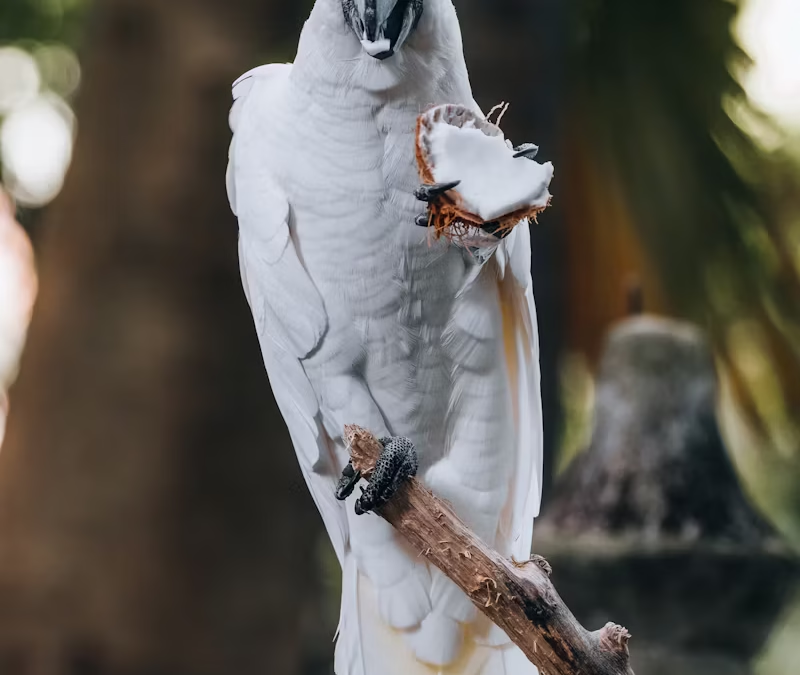Parrot feather plucking
Parrot Feather Plucking: Causes, Treatment, and Prevention
Feather plucking is one of the most concerning behaviors parrot owners face. When a bird starts pulling out its own feathers, it’s not just a cosmetic issue it’s a clear signal that something is wrong. Whether it’s stress, health problems, or environmental triggers, feather plucking in parrots is a complex condition that requires prompt attention.
In this post, we’ll explore the common causes of feather plucking, how to identify the underlying issue, and effective strategies for treatment and prevention. With the right care, knowledge, and environment, many parrots can recover and regain a healthy, vibrant plumage.
What Is Feather Plucking?
Feather plucking (also known as feather picking or self-mutilation) is when a bird pulls out or damages its feathers repeatedly. It’s important to distinguish this from normal preening, which is a healthy grooming activity. Plucking, on the other hand, can lead to bald spots, skin irritation, and even open wounds if left untreated.
Feather plucking is especially common in highly intelligent and emotional birds such as:
• African Grey Parrots
• Cockatoos
• Macaws
• Amazons
• Eclectus Parrots
Why Do Parrots Pluck Their Feathers?
Feather plucking can have multiple causes, and sometimes more than one is at play. Understanding the root of the behavior is the first step toward recovery.
1. Psychological Causes
• Boredom: Parrots are intelligent and need regular stimulation. A lack of toys, interaction, or mental engagement can lead to self-destructive behavior.
• Loneliness: Parrots are social creatures. If left alone too long, they may develop separation anxiety.
• Stress or trauma: Changes in the home, loud noises, or past abuse can trigger plucking.
2. Environmental Causes
• Poor cage conditions: Small, dirty, or unstimulating cages contribute to behavioral issues.
• Inadequate lighting or sleep: Parrots need 10–12 hours of uninterrupted sleep and natural light.
• Exposure to toxins: Smoke, aerosols, or Teflon fumes can irritate the skin or lungs, prompting plucking.
3. Medical Causes
• Skin infections or parasites like mites or lice can cause itching.
• Nutritional deficiencies, especially lack of Vitamin A or calcium, affect feather and skin health.
• Liver or kidney disease, hormonal imbalances, or allergies may also play a role.
Always consult an avian veterinarian to rule out or treat underlying health conditions.
How to Diagnose Feather Plucking Causes
Diagnosing feather plucking requires a comprehensive approach that includes:
• Veterinary exam: Blood tests, skin scrapings, and physical evaluations can identify medical causes.
• Behavioral assessment: Track when plucking occurs—during certain times, around specific people, or after changes in routine.
• Environmental review: Evaluate cage size, cleanliness, lighting, and household noise or activity levels.
Understanding the “why” behind the behavior is key to creating a treatment plan.
Effective Treatments for Feather Plucking
Once the cause is identified, treatment can begin. There is no one-size-fits-all solution, but many birds show improvement with a combination of the following:
1. Environmental Enrichment
• Provide a variety of toys: foraging, shredding, and puzzle toys.
• Allow daily out-of-cage time and safe exploration.
• Play music or leave on bird-safe videos when you’re away.
2. Improve Nutrition
• Switch to a high-quality pellet diet supplemented with fresh fruits, vegetables, and leafy greens.
• Avoid seed-only diets, which lack essential nutrients.
3. Reduce Stress
• Maintain a predictable routine.
• Avoid sudden changes in environment or handling.
• Ensure your parrot has a quiet, dark place to sleep.
4. Behavioral Training
• Use positive reinforcement to redirect attention away from plucking.
• Teach new tricks to stimulate the brain and boost confidence.
5. Medical Interventions
• Treat infections, parasites, or underlying diseases.
• Some cases may require temporary collars or plucking deterrents, but these should only be used under veterinary supervision.
Can Feather Plucking Be Reversed?
In many cases, yes—but it takes time. Feathers may regrow if the follicle is intact. However, chronic plucking can damage follicles permanently. Early intervention greatly improves recovery chances. Even if full feather regrowth isn’t possible, behavioral and environmental changes can stop the habit from worsening.
How to Prevent Feather Plucking in the First Place
Prevention is always better than treatment. Here’s how to set your bird up for long-term health:
• Provide a rich and stimulating environment from the start.
• Stick to a healthy diet with proper supplements.
• Keep your bird socially engaged with daily interaction.
• Schedule regular vet checkups with an avian specialist.
• Avoid stress triggers and give your parrot the routine it craves.
Final Thoughts: Understanding Is Key
Feather plucking in parrots is a sign that something deeper is going on—physically, emotionally, or both. By paying attention to your bird’s needs and making intentional changes, you can often stop the behavior and dramatically improve their quality of life.
Remember: your bird isn’t being “bad”—it’s trying to communicate. With compassion, consistency, and care, healing is possible.

